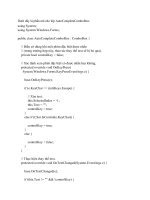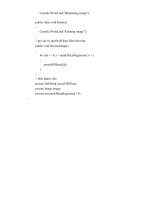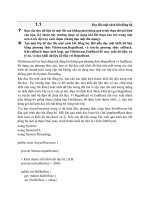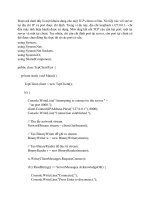Marine Geology Phần 3 docx
Bạn đang xem bản rút gọn của tài liệu. Xem và tải ngay bản đầy đủ của tài liệu tại đây (1.63 MB, 34 trang )
MAGNETIC SURVEYS
Geologists looking for a decisive test for seafloor spreading stumbled upon
magnetic reversals on the ocean floor. Recognition of the reversal of the geo-
magnetic field began in the early 1950s. In 1963, the British geologists Fred
Vine and Drummond Mathews thought that magnetic reversal would be a
decisive test for seafloor spreading. Experiments using sensitive magnetic
recording instruments called magnetometers towed behind ships over the
midocean ridges (Fig. 40) revealed magnetic patterns locked in the volcanic
rocks on the seafloor.These patterns alternated from north to south and were
mirror images of each other on both sides of the ridge crest. The magnetic
fields captured in the rocks also showed the past position of the magnetic poles
as well as their polarities.
As the iron-rich basalts of the midocean ridges cool, the magnetic fields
of their iron molecules line up in the direction of Earth’s magnetic field at the
time of their deposition. As the ocean floor spreads out on both sides of the
ridge, the basalts solidify. They establish a record of the geomagnetic field at
each successive reversal, somewhat like a magnetic tape recording of the his-
Figure 40 A crew
member lowers a
magnetometer over the
stern of the oceanographic
research ship USNS
Hayes.
(Photo courtesy U.S. Navy)
54
Marine Geology
tory of the geomagnetic field. Normal polarities in the rocks are reinforced by
the present magnetic field, while reversed polarities are weakened by it. This
process produced parallel bands of magnetic rocks of varying width and mag-
nitude on both sides of the ridge crest (Fig. 41). Here at last was clinching
proof for seafloor spreading. In order for the magnetic stripes to form in such
a manner, the ocean floor had to be pulling apart.
Two or three times every million years, Earth’s geomagnetic field
reverses polarity, with the north and south magnetic poles switching places.
Over the last 4 million years, the field reversed 11 times. Over the last 170 mil-
lion years, Earth’s magnetic field has reversed 300 times. No reversals occurred
during long stretches of the Permian and Cretaceous periods. Furthermore, a
sudden polar shift of 10 to 15 degrees occurred between 100 million and 70
million years ago.
Since about 90 million years ago, reversals have steadily become more fre-
quent, and the polar wandering has decreased to only about 5 degrees.The last
time the geomagnetic field reversed was about 780,000 years ago, and Earth
appears to be well overdo for another one.The magnetic field in existence 2,000
years ago was considerably stronger than it is today. Earth’s magnetic field seems
to have weakened over the past 150 years, amounting to a loss of about 1 per-
cent per decade. If the present rate of decay continues, the field could reach zero
and go into another reversal within the next 1,000 years or so.
Figure 41 Magnetic
stripes on the ocean floor
are mirror images of each
other and indicate that the
ocean crust is spreading
apart.
55
Marine Exploration
Midocean ridge
The magnetic stripes also provided a means of dating practically the
entire ocean floor.This is because the magnetic reversals occur randomly and
any set of patterns is unique in geologic history (Table 6).The rate of seafloor
spreading was calculated by determining the age of the magnetic stripes by
dating drill cores taken from the midocean ridge and measuring the distance
from their points of origin at the ridge crest. During the past 100 million
years, the rate of seafloor spreading has changed little. Periods of increased
acceleration were accompanied by an increase in volcanic activity. During the
past 10 to 20 million years, a progressive acceleration has occurred, reaching a
peak about 2 million years ago.
The spreading rates on the East-Pacific Rise are upward of 6 inches per
year, which results in less topographical relief on the ocean floor. The active
tectonic zone of a fast-spreading ridge is usually quite narrow, generally less
that 4 miles wide. In the Atlantic, the rates are much slower, only about 1 inch
per year. This allows taller ridges to form. Calculating the rate of seafloor
spreading for the Atlantic indicates that it began to open around 170 million
years ago—a time span remarkably concurrent with the estimated date for the
breakup of the continents.
SATELLITE MAPPING
In 1978, the radar satellite Seasat (Fig. 42) precisely measured the distance to
the ocean surface over most of the globe. Buried structures beneath the ocean
56
Marine Geology
TABLE 6 COMPARISON OF MAGNETIC REVERSALS WITH
OTHER PHENOMENA (DATES IN MILLIONS OF YEARS)
Magnetic Unusual Meteorite Sea Level Mass
Reversal Cold Activity Drops Extinctions
0.7 0.7 0.7
1.9 1.9 1.9
2.0 2.0
10 11
40 37–20 37
70 70–60 65
130 132–125 137
160 165–140 173
floor appeared in full view for the first time.Among the astonishing discover-
ies was the fact that ridges and trenches on the ocean bottom produce corre-
sponding hills and valleys on the surface of the ocean because of variations in
the pull of gravity. The topography of the ocean surface showed bulges and
depressions with a relief between highs and lows as much as 600 feet. How-
Figure 42 Artist’s
concept of the Seasat A
satellite as it studies the
oceans from Earth orbit.
(Photo courtesy USGS)
57
Marine Exploration
ever, because these surface variations range over a wide area, they are gener-
ally unrecognized on the open sea.
The pull of gravity from undersea mountains, ridges, trenches, and other
structures of varying mass distributed over the seafloor controls the shape of the
surface water. Undersea mountain ranges produce large gravitational forces that
cause seawater to pile up around them, resulting in gentle swells on the ocean
surface. Conversely, submarine trenches with less mass to attract water form
shallow troughs in the sea surface. For example, a trench 1 mile deep can cause
the ocean to drop dozens of feet. A gravity low, a deviation of the gravity value
from the theoretical value, formed as a plate sinks into the mantle off Somalia
in northwest Africa might well be the oldest trench in the world.
The satellite altimetry data was used to produce a map of the entire
ocean surface (Fig. 43), representing the seafloor as much as 7 miles deep.
Chains of midocean ridges and deep-sea trenches were delineated with a clar-
ity greater than had been achieved with any other method of mapping the
ocean floor.The seafloor maps also uncovered many new features such as rifts,
ridges, seamounts, and fracture zones and better defined several known fea-
tures.The maps provided additional support for the theory of plate tectonics.
This theory holds that the crust is broken into several plates whose constant
shifting is responsible for the geologic activity on Earth’s surface, including the
growth of mountain ranges and the widening of ocean basins.
The satellite imagery also revealed long-buried parallel fracture zones
undiscovered by conventional seafloor-mapping techniques. The faint lines
running like a comb through the central Pacific seafloor might be controlled
Figure 43 Radar
altimeter data from the
Geodynamic
Experimental Ocean
Satellite (GEOS-3) and
Seasat produced this map
of the ocean floor. (1)
Mid-Atlantic Ridge, (2)
Mendocino Fracture Zone,
(3) Hawaiian Islands, (4)
Tonga Trench, (5)
Emperor Seamounts, (6)
Aleutian Trench, (7)
Mariana Trench, (8)
Ninety East Ridge.
(Photo courtesy NASA)
58
Marine Geology
by convection currents in the mantle 30 to 90 miles beneath the oceanic
crust. Each circulating loop consists of hot material rising and cooler material
sinking back into the depths, tugging on the ocean floor as it descends.
The data also revealed a fracture zone in the southern Indian Ocean that
shows India’s break from Antarctica around 180 million years ago.The 1,000-
mile-long gash, located southwest of the Kerguelen Islands, was gouged out of
the ocean floor as the Indian subcontinent inched northward.When India col-
lided with Asia, more than 100 million years after it was set adrift, it pushed
up the Himalaya Mountains to great heights like squeezing an accordion. A
strange series of east-west wrinkles in the ocean crust just south of India ver-
ifies that the Indian plate is still pushing northward, continuously raising the
Himalayas and shrinking the Asian continent by as much as 3 inches a year.
Even buried structures came into full view for the first time. One exam-
ple is an ancient midocean ridge that formed when South America, Africa,
and Antarctica began separating around 125 million years ago. The seafloor-
spreading center was buried deep under thick layers of sediments.The bound-
ary between the plates moved westward, leaving behind the ancient ridge,
which began to subside.The ridge’s discovery might help trace the evolution
of the oceans and continents over the last 200 million years.The satellite data
provided further proof that the deep-sea floor remains, in large part, uncharted
territory and that the exploration of inner space is just as important as the
exploration of outer space.
After exploring the ocean floor, the next chapter searches the seabed for
evidence for plate tectonics, the force that moves great chunks of crust around
the surface of Earth and that is responsible for geologic activity on the planet.
59
Marine Exploration
60
T
his chapter examines the ocean’s role in plate tectonics, the process
that changes the face of Earth. The ocean’s crust is constantly
changing. It is relatively young compared with continental crust
and is less than 5 percent of Earth’s age. The age difference is due to the
recycling of oceanic crust into the mantle. Almost all the ocean floor has
disappeared into Earth’s interior over the last 170 million years.The oceanic
crust is continuously being created at midocean ridges, where basalt oozes
out of the mantle through rifts in the crust. It is destroyed in deep-sea
trenches, where the lithosphere plunges into the mantle and remelts in a
continuous cycle.
The divergence of lithospheric plates generates new oceanic crust at
spreading ridges, while convergence devours old oceanic crust in subduction
zones.When two plates collide, the less buoyant oceanic crust subducts under
continental crust. The lithosphere and the overriding oceanic crust recycle
through the mantle to make new crust. The lithospheric plates act like rafts
riding on a sea of molten rock, slowly carrying the continents around the sur-
face of the globe.
The Dynamic Seafloor
The Oceanic Crust
3
LITHOSPHERIC PLATES
Earth’s outer shell is fractured like a cracked egg into several large lithospheric
plates (Fig. 44).The shifting plates range in size from a few hundred to several
million square miles. They comprise the crust and the upper brittle mantle
called the lithosphere.The lithosphere consists of the rigid outer layer of the
mantle and underlies the continental and oceanic crust.The thickness of the
lithosphere is about 60 miles under the continents and averages about 25 miles
under the ocean.
Most continental rock originated when volcanoes stretching across the
ocean were drawn together by plate tectonics. With the inclusion of conti-
nental margins and small shallow regions in the ocean, the continental crust
covers about 45 percent of Earth’s surface. It varies from 6 to 45 miles thick
and rises on average about 4,000 feet above sea level.The thinnest parts of the
continental crust lie below sea level on continental margins, and the thickest
portions underlie mountain ranges.
The oceanic crust, by comparison, is considerably thinner and in most
places is only 3 to 5 miles thick. Oceanic crust is only a small fraction of the
age of continental crust, because the mantle at subduction zones spread
around the world has consumed the older ocean floor. Perhaps as many as 20
oceans have come and gone during the last 2 billion years by the action of
plate tectonics.
Figure 44 The
lithospheric plates that
comprise Earth’s crust.
61
The Dynamic Seafloor
Pacific Plate
Indian-Australian
Plate
Nazca
Plate
North American Plate
South American Plate
African
Plate
Eurasian Plate
Arabian
Plate
Indian-
Australian
Plate
Antarctic
Plate
Antarctic
Plate
Eurasian Plate
Caribbean
Plate
Cocos
Plate
Philippine
Plate
The lithosphere averages about 60 miles thick. It rides freely on the
semimolten outer layer of the mantle, called the asthenosphere, between
about 70 and 150 miles deep.This feature is necessary for the operation of
plate tectonics. Otherwise, the crust would be jumbled-up slabs of rock.
Instead, eight major and about a half-dozen minor lithospheric plates
carry the crust around on a sea of molten rock. The plates diverge at mido-
cean ridges and converge at subduction zones, which are expressed on the
ocean floor as deep-sea trenches.The trenches are regions where the plates are
subducted into the mantle and remelted.The plates and oceanic crust are con-
tinuously recycled through the mantle. However, because of its greater buoy-
ancy, the continental crust is rarely subducted.
An interesting feature about the crust geologists found quite by accident
was that Scandinavia and parts of Canada are slowly rising nearly half an inch
a year. Over the centuries, mooring rings on harbor walls in Baltic seaports
have risen so far above sea level they could no longer be used to tie up ships.
During the last ice age, the northern landmasses were covered with ice sheets
up to 2 miles thick. Under the weight of the ice, North America and Scandi-
navia began to sink like an overloaded ship.
When the ice began to melt about 12,000 years ago, the extra weight
was removed. As a result, the crust became lighter and began to rise (Fig. 45).
In Scandinavia, marine fossil beds have risen more than 1,000 feet above sea
level since the last ice age.The weight of the ice sheets depressed the landmass
when the marine deposits were being laid down.When the ice sheets melted,
the removal of the weight caused the landmass to rebound.
The lithospheric plates ride on a hot, pliable layer or asthenosphere in a
manner similar to hard wax floating on melted wax.They carry the crust like
drifting slabs of rock. The plates diverge at midocean spreading ridges and
converge at subduction zones, lying at the edges of lithospheric plates. The
lithospheric plates subduct into the mantle in a continuous cycle of crustal
regeneration.Their constant interaction with each other shapes the surface of
the planet.This structure of the upper mantle is important for the operation
of plate tectonics, which is responsible for all geologic activity.
The plate boundaries are zones of active deformation that absorb the
force of impact between nearly rigid plates.Throughout much of the world,
clear geologic features, such as mountain ranges or deep ocean trenches, mark
the boundaries between plates. These boundary zones vary from a few hun-
dred feet where plates slide past each other at transform faults to several tens
of miles at midocean ridges and subduction zones.
The divergent plate margins are midocean spreading ridges. These are
regions where basalt welling up from within the upper mantle creates new
oceanic crust as part of the process of seafloor spreading (Fig. 46).The midocean
62
Marine Geology
ridge system, which is not always found in the middle of the ocean, snakes
46,000 miles around the globe, making it the longest structure on Earth. The
lateral plate margins are transform faults. These are regions where plates slide
past each other accompanied by little or no tectonic activity, such as the
upwelling of magma and the generation of earthquakes.
The convergent plate margins are the subduction zones represented by
deep-sea trenches, where old oceanic crust sinks into the mantle to provide
magma for volcanoes fringing the trenches. If tied end to end, the subduction
zones would stretch completely around the world. The convergence rates
between plates range from less than 1 inch to more than 5 inches per year,
corresponding to the rates of plate divergence. However, subduction zones
and associated spreading ridges on the margins of a plate do not operate at the
same rates.This disparity causes the plates to travel across the surface of Earth.
If subduction overcomes seafloor spreading, the lithospheric plate shrinks and
eventually disappears altogether.
The oceanic plates thicken with age from a few miles thick, after for-
mation at midocean spreading ridges, to more than 50 miles thick in the old-
est ocean basins next to the continents.The depth at which an oceanic plate
Figure 45 The
principle of isostasy. Land
covered with ice readjusts
to the added weight like a
loaded freighter.When the
ice melts, the land is
buoyed upward as the
weight lessens.
63
The Dynamic Seafloor
sinks as it moves away from a midocean spreading ridge varies by age. For
example, a plate 2 million years old lies about 2 miles deep; a plate 20 million
years old lies about 2.5 miles deep; and a plate 50 million years old lies about
3 miles deep.
A typical oceanic plate starts out thin. It thickens by the underplanting
of new lithosphere from the upper mantle and by the accumulation of over-
lying sediment layers.The ocean floor at the summit of a midocean ridge con-
sists almost entirely of hard basalt and acquires a thickening layer of sediments
farther outward from the ridge crest. By the time the oceanic plate spreads out
as wide as the Atlantic Ocean, the portion near continental margins where the
sea is the deepest is about 60 miles thick. Eventually, the oceanic plate
becomes so thick and heavy it can no longer remain on the surface. It then
bends downward and subducts beneath a continent or another oceanic plate
into Earth’s interior (Fig. 47).
As the oceanic plate plunges into a subduction zone, it remelts and
acquires new minerals from the mantle.This process provides the raw mater-
ial for new oceanic crust as molten magma reemerges at volcanic spreading
centers along midocean ridges. Sediments deposited onto the ocean floor and
the water trapped between sediment grains are also caught in the subduction
zones. However, the lower melting points and lesser density of these molten
sediments cause them to rise toward the surface to supply nearby volcanoes
with magma and recycled seawater.
Much more water is being subducted into Earth than emerges from sub-
duction zone volcanoes. Heat and pressure act to dehydrate rocks of the
Figure 46 Creation of
oceanic crust at a
spreading ridge.
64
Marine Geology
Magma
body
Axial
rift
descending plate. However, just where all the fluid goes has remained a mystery.
Some fluid expelled from a subducting plate reacts with mantle rocks to pro-
duce low-density minerals that slowly rise to the seafloor.There they build mud
volcanoes that erupt serpentine, an asbestos mineral formed by the reaction of
water with olivine from the mantle, a silicate rich in iron and magnesium.
When the sediments and their contained seawater are caught between a
subducting oceanic plate and an overriding continental plate, they are sub-
jected to strong deformation, shearing, heating, and metamorphism. As the
rigid lithospheric plate carrying the oceanic crust descends into Earth’s inte-
rior, it slowly breaks up and melts. Over a period of millions of years, it is
absorbed into the general circulation of the mantle.The subducted plate also
supplies molten magma for volcanoes, most of which ring the Pacific Ocean
and recycle chemical elements to Earth.
OCEANIC CRUST
The crust of the ocean is remarkable for its consistent thickness and temper-
ature (Table 7). It averages about 4 miles thick and does not vary more than
20 degrees Celsius over most of the globe. Most oceanic crust is less than 4
percent of Earth’s age and younger than 170 million years, with a mean age
Figure 47 The
subduction of the ocean
floor provides new molten
magma for volcanoes that
fringe the deep-sea
trenches.
65
The Dynamic Seafloor
Oceanic
trench
Frictional Melting
Frictional Melting
Crust
scrappings
Continental Mass
Oceanic crust moving
to mid-mantle
remelting
Oceanic crust moving
to mid-mantle
remelting
Upper Mantle
Magma
Rising
magma
Silt
of 100 million years.This is relatively young compared with continental crust,
which is about 4 billion years old. Most of the seafloor has since disappeared
into Earth’s interior to provide the raw materials for the continued growth of
the continents.The average density of continental crust is 2.7 times the den-
sity of water, compared with 3.0 for oceanic crust and 3.4 for the mantle.The
difference in density buoys up the continental and oceanic crust.
Oceanic crust does not form as a single homogeneous mass. Instead, it
comprises long, narrow ribbons laid side by side with fracture zones in
between. The oceanic crust is comparable to a layer cake with four distinct
strata (Fig. 48).The upper layer is pillow basalts, formed when lava extruded
undersea at great depths.The second layer is of a sheeted-dike complex, con-
sisting of a tangled mass of feeders that brought magma to the surface. The
third layer is of gabbros, which are coarse-grained rocks that crystallized slowly
under high pressure in a deep magma chamber. The fourth layer is of peri-
dotites segregated from the mantle below. Gabbros containing higher amounts
of silica solidify out of the basaltic melt and accumulate in the lower layer of
the oceanic crust.
The same rock formation is found on the continents.This similarity led
geologists to speculate that these formations were pieces of ancient oceanic
66
Marine Geology
TABLE 7 CLASSIFICATION OF THE EARTH’S CRUST
Tectonic Thickness Geologic
Environment Crust Type Character in Miles Features
Continental crust Shield Very stable 22 Little or no sediment,
overlying stable mantle exposed Precambrian rocks
Midcontinent Stable 24
Basin and range Very unstable 20 Recent normal faulting, vol-
canism, and intrusion; high
mean elevation
Continental crust Alpine Very unstable 34 Rapid recent uplift, relatively
overlying unstable mantle recent intrusion; high mean
elevation
Island arc Very unstable 20 High volcanism, intense
folding and faulting
Oceanic crust overlying Ocean basin Very stable 7 Very thin sediments overlying
stable mantle basalts, no thick Paleozoic
sediments
Oceanic crust overlying Ocean ridge Unstable 6 Active basaltic volcanism,
unstable mantle little or no sediment
crust called ophiolites, from the Greek word ophis, meaning “serpent.” Ophi-
olites, so-named because of their mottled green color, date as far back as 3.6
billion years.These rocks were slices of ocean floor shoved up onto the con-
tinents by drifting plates.Therefore, ophiolites are among the best evidence for
ancient plate motions.
Ophiolites are vertical cross sections of oceanic crust peeled off during
plate collisions and plastered onto the continents.This action produced a lin-
ear formation of greenish volcanic rocks along with light-colored masses of
granite and gneiss, common igneous and metamorphic rocks. Pillow lavas
(Fig. 49), tubular bodies of basalt extruded undersea, are also found in the
greenstone belts, signifying that these volcanic eruptions took place on the
ocean floor. Many ophiolites contain ore-bearing rocks that are important
mineral resources throughout the world.
Spreading ridges, where basalt oozes out of the mantle through rifts on
the ocean floor, generate about 5 cubic miles of new oceanic crust every year.
Some molten magma erupts as lava on the surface of the ridge through a sys-
tem of vertical passages. Once at the surface, the liquid rock flows down the
ridge and hardens into sheets or rounded forms of pillow lavas, depending on
the rate of extrusion and the slope of the ridge. Periodically, lava overflows
onto the ocean floor in gigantic eruptions, providing several square miles of
new oceanic crust yearly. As the oceanic crust cools and hardens, it contracts
and forms fractures through which water circulates.
Magma rising from the upper mantle extrudes onto the ocean floor
and bonds to the edges of separating plates. Much of the magma solidifies
Figure 48 The oceanic
crust comprises a top layer
of pillow basalts, a second
layer of sheeted dikes, a
third layer of gabbros, and
an underlying layer of
layered peridotites above
the mantle.
67
The Dynamic Seafloor
Basaltic rocks (SIma)
Sheeted dikes
Sheeted dikes
Gabbros
Gabbros
Peridotites
Peridotites
Mantle
Magma
body
Pillow basalts,
Pillow basalts
within the conduits above the magma chamber, forming massive vertical
sheets called dikes that resemble a deck of cards standing on end. Individual
dikes measure about 10 feet thick, stretch about 1 mile wide, and range
about 3 miles long.
The asthenosphere is the fluid portion of the upper mantle, where rocks
are semimolten or plastic, enabling them to flow slowly.After millions of years,
the molten rocks reach the topmost layer of the mantle, or lithosphere.With
a reduction of pressure within Earth, the rocks melt and rise through fractures
in the lithosphere. As the molten magma passes through the lithosphere, it
reaches the bottom of the oceanic crust, where it forms magma chambers that
further press against the crust, which continues to widen the rift. Molten lava
pouring out of the rift forms ridge crests on both sides and adds new mater-
ial to the spreading ridge system (Fig. 50).
The mantle material below spreading ridges where new oceanic crust
forms is mostly peridotite, a strong, dense rock composed of iron and magne-
sium silicates.As the peridotite melts on its journey to the base of the oceanic
crust, a portion becomes highly fluid basalt, the most common magma
erupted on the surface of Earth. About 5 cubic miles of basaltic magma are
removed from the mantle and added to the crust every year. Most of this vol-
canism occurs on the ocean floor at spreading centers, where the oceanic crust
pulls apart.
The oceanic crust, composed of basalts originating at spreading ridges
and sediments washed off continents and islands, gradually increases density
Figure 49 Pillow lava
on the south bank of
Webber Creek, Eagle
District, Alaska.
(Photo by E. Blackwelder,
courtesy USGS)
68
Marine Geology
and finally subducts into the mantle. On its way deep into Earth’s interior, the
lithosphere and its overlying sediments melt.The molten magma rises toward
the surface in huge bubblelike structures called diapirs, from the Greek word
diapeirein, meaning “to pierce.”When the magma reaches the base of the crust,
it provides new molten rock for magma chambers beneath volcanoes and
granitic bodies called plutons such as batholiths (Fig. 51), which often form
mountains. In this manner, plate tectonics is continuously changing and rear-
ranging the face of Earth.
Figure 50 Cross section
of Earth beneath the
Mid-Atlantic Ridge,
which separated the New
World from the Old
World.
69
The Dynamic Seafloor
Continent Continent
Asthenosphere
Mid-ocean ridge
Lithosphere
Lithosphere
Batholith
Batholith
Stock
Sill
Laccolith
Dike
Dike
Figure 51 A cutaway
view of intrusive magma
bodies that invade Earth’s
crust and erupt on the
surface as volcanoes.
THE ROCK CYCLE
The development of the theory of plate tectonics has led to a greater under-
standing of the geochemical carbon cycle or simply rock cycle.The rock cycle
is extremely crucial for keeping the planet alive both geologically and biolog-
ically. The recycling of carbon through the geosphere makes Earth unique
among planets.This is evidenced by the fact that the atmosphere contains large
amounts of oxygen.Without the carbon cycle, oxygen would have long since
been buried in the geologic column, comprising the sedimentary rocks that
make up the crust. Fortunately, plants replenish oxygen by utilizing carbon
dioxide, which plays a critical role as a primary source of carbon for photo-
synthesis and therefore provides the basis for all life.
The entire volume of the world’s oceans circulates through the crust at
spreading ridges every 10 million years. This circulation is approximately
equivalent to the annual flow of the Amazon, the world’s largest river. This
action accounts for the unique chemistry of seawater and for the efficient
thermal and chemical exchanges between the crust and the ocean.The mag-
nitude of some of these chemical exchanges is comparable in volume to the
input of elements into the oceans by the world’s rivers, which carry materials
weathered from the continents. The most important of these chemical ele-
ments is carbon, which controls many life processes on the planet.
When the seafloor subducts into Earth’s interior, the intense heat of the
mantle drives out carbon dioxide from carbonaceous sediments. The molten
rock, with its contingent of carbon dioxide, flows upward through the mantle
and fills the magma chambers underlying volcanoes and spreading ridges.The
consequent eruption of volcanoes and the flow of molten rock from mido-
cean ridges resupplies the atmosphere with new carbon dioxide, making Earth
one great carbon dioxide recycling plant (Fig. 52).
The geochemical carbon cycle is the transfer of carbon within Earth and
involves the interactions between the crust, ocean, atmosphere, and life (Table
8). Many aspects of this important cycle were understood around the turn of
the 20th century, notably by the American geologist Thomas Chamberlain
and chemist Harold Urey, who developed the theory. However, only in the last
few years has the geochemical carbon cycle been placed within the more
comprehensive framework of plate tectonics.
The biologic carbon cycle is only a small component of this cycle. It is
the transfer of carbon from the atmosphere to vegetation by photosynthesis
and then the returning of carbon to the atmosphere when plants respire or
decay. Only about one-third of the chemical elements, mostly hydrogen, oxy-
gen, carbon, and nitrogen, comprising most of the elements of life, are recy-
cled biologically.The vast majority of carbon is not stored in living tissue but
locked up in sedimentary rocks. Even the amount of carbon contained in fos-
70
Marine Geology
sil fuels is meager by comparison.The combustion of large quantities of fossil
fuels and the destruction of the world’s forests is transferring more carbon to
the atmosphere than can be disposed of in the ocean, which holds by far the
largest store of carbon dioxide.The burning of carbon-based fuels could dra-
matically influence the climate through the greenhouse effect.
The biosphere, the living portion of the planet, plays a very important
role in the cycling of carbon. The creation and decomposition of peat bogs
might have been responsible for most changes in levels of atmospheric carbon
dioxide during the past two glaciations. The bogs have accumulated upward
of 250 billion tons of carbon in the last 10,000 years since the end of the last
ice age, mostly in the temperate zone of the Northern Hemisphere. Over geo-
logic time, progressively more land has drifted into latitudes where large quan-
tities of carbon are stored as peat. During the last million years, glaciations
have gradually remolded large parts of the Northern Hemisphere into land-
forms more suitable for peat bog formation in wetlands.
Carbon dioxide presently comprises about 365 parts per million of the
air molecules in the atmosphere, amounting to about 800 billion tons of car-
bon. It is one of the most important greenhouse gases, which traps solar heat
that would otherwise escape into space. Carbon dioxide, therefore, operates
Figure 52 The
geochemical carbon cycle.
Carbon dioxide in the
form of bicarbonate is
washed off the land and
enters the ocean, where
organisms convert it to
carbonate sediments, which
are thrust into the mantle,
become part of the
magma, and escape into
the atmosphere from
volcanoes.
71
The Dynamic Seafloor
CO
2
H
2
CO
3
CaCO
3
somewhat like a thermostat to regulate the temperature of the planet. Since it
plays such a critical role in regulating Earth’s temperature, major changes in
the carbon cycle could have profound climatic effects. If the carbon cycle
removes too much carbon dioxide, Earth cools. If the carbon cycle generates
too much carbon dioxide, Earth warms.Therefore, even slight changes in the
carbon cycle could have a considerable influence on the climate.
The ocean plays a crucial role in the carbon cycle by regulating the level
of carbon dioxide in the atmosphere. In the upper layers of the ocean, the con-
centration of gases is in equilibrium with the atmosphere.The mixed layer of
the ocean (Fig. 53), within the upper 300 feet, contains as much carbon diox-
ide as the entire atmosphere.The gas dissolves into seawater mainly by the agi-
tation of surface waves. Without marine photosynthetic organisms to absorb
dissolved carbon dioxide, much of the ocean’s reservoir of this gas would
escape into the atmosphere, more than tripling the present content and caus-
ing a runaway greenhouse effect.
A major portion of the carbon in the ocean comes from the land.
Atmospheric carbon dioxide combines with rainwater to form carbonic acid.
The acid reacts with surface rocks, producing dissolved calcium and bicar-
bonate, which are carried by streams to the sea. Marine organisms use these
substances to build calcium carbonate skeletons and other supporting struc-
tures.When the organisms die, their skeletons sink to the bottom of the ocean,
where they dissolve in the deep abyssal waters. Because of its large volume, the
abyss holds the largest reservoir of carbon dioxide, containing 60 times more
carbon than the atmosphere.
Sediments on the ocean floor and on the continents store most of the
carbon in carbonate rocks. In shallow water, the carbonate skeletons build
72
Marine Geology
TABLE 8 The Amount of Carbon Relative to Life
Source Relative Amount
Calcium carbonate in sedimentary rocks 60,000
Ca-Mg carbonate in sedimentary rocks 45,000
Sedimentary organic matter in the remains of animal tissues 25,000
Bicarbonate and carbonate dissolved in ocean 75
Coal and petroleum 7
Soil humus 5
Atmospheric carbon dioxide 1.5
All living plants and animals 1
deposits of limestone (Fig. 54), which buries carbon dioxide in the geologic
column. The burial of carbonate is responsible for about 80 percent of the
carbon deposited onto the ocean floor. The carbon locked up in carbonate
minerals in the upper crust is estimated at 800 trillion tons.The remainder
of the carbonate originates from the burial of dead organic matter washed
off the continents.
In this respect, marine life acts as a pump to remove carbon dioxide from
the atmosphere and the ocean’s surface waters and store it in the deep sea.The
faster this biologic pump works, the more carbon dioxide that is removed
from the atmosphere, with the rate determined by the amount of nutrients in
the ocean. A reduction of nutrients slows the pump, returning deep-sea car-
bon dioxide to the atmosphere.
Half the carbonate transforms back into carbon dioxide, which returns
to the atmosphere, mostly by upwelling currents in the tropics.Therefore, the
concentration of atmospheric carbon dioxide is highest near the equator. If
not for this process, in a mere 10,000 years all carbon dioxide would be
removed from the atmosphere. Without the return of carbon dioxide to the
atmosphere, photosynthesis would cease and all life would end.
The deep water, which represents about 90 percent of the ocean’s vol-
ume, circulates very slowly with a residence time (time in place) of about
1,000 years. It comes into direct contact with the atmosphere only in the polar
regions. Thus, the deep water’s absorption of carbon dioxide is limited. The
Figure 53 Turbulence
in the upper layers of the
ocean induces the mixing
of temperatures, nutrients,
and gases.
73
The Dynamic Seafloor
Wind
Wind row
Breaking
waves
Breaking internal waves
Shear turbulence
Convection
abyss receives most of its carbon as shells of dead organisms and fecal matter
that sink to the ocean bottom.
Volcanic activity on the ocean floor and on the continents plays a vital
role in restoring the carbon dioxide content of the atmosphere. Carbon diox-
ide escapes from carbonaceous sediments that melt in Earth’s interior to pro-
vide new magma.The molten magma along with volatiles including water and
carbon dioxide rise to the surface to feed magma chambers beneath midocean
ridges and volcanoes.When the volcanoes erupt, carbon dioxide releases from
the magma and returns to the atmosphere, completing the cycle.
The cycling of carbon through land, ocean, and atmosphere is significant
in determining potential climate change. Atmospheric scientists are particu-
larly interested in knowing what role rising concentrations of carbon dioxide,
an important greenhouse gas, might play in warming Earth’s climate.
Researchers do not know how Earth stores much of the carbon dioxide
released by human activity or whether the planet’s storage capacity for the gas
can continue indefinitely.Therefore, decisions about any future actions regard-
ing management of the carbon cycle will require additional scientific inquiry.
OCEAN BASINS
Ocean basins are the largest and deepest depressions on Earth. The ocean
floor lies much deeper below sea level than the continents rise above it. If
the oceans were completely drained of water, the planet would look much
like the rugged surface of Venus, which lost its oceans eons ago.The deep-
est parts of the dry seabed would lie several miles below the surrounding
Figure 54 The
formation of limestone
from carbonaceous
sediments deposited onto
the ocean floor.
74
Marine Geology
Rain of calcite from organisms
Carbonate-free zone
Rain of calcite from organisms
Calcite ooze
continental margins. The floor of the desiccated ocean would be traversed
by the longest mountain ranges and fringed in places by the deepest
trenches.Vast empty basins would divide the continents, which would stand
out like thick slabs of rock.
Most of the seawater surrounding the continents lies in a single great
basin in the Southern Hemisphere, which is nine-tenths ocean. It branches
northward into the Atlantic, Pacific, and Indian basins in the Northern
Hemisphere, where most of the continental landmass exists. The Arctic
Ocean is a nearly landlocked sea connected to the Atlantic and Pacific by
narrow straits.The Bering Sea separates Alaska and Asia by only 56 miles at
its narrowest point (Fig. 55). About 20 million years ago, a ridge near Ice-
land subsided, allowing cold water from the recently formed Arctic Ocean
to surge into the Atlantic, giving rise to the oceanic circulation system in
existence today (Table 9).
The oceans expand across some 70 percent of Earth’s surface.They cover
an area of about 140 million square miles with more than 300 million cubic
Figure 55 The Bering
Strait between Alaska and
Asia.
75
The Dynamic Seafloor
Arctic
Ocean
Bering
Sea
Alaska
(UNITED STATES)
RUSSIA
B
e
r
i
n
g
S
t
r
a
i
t
0 400 Miles
0
400 Kms
N
miles of seawater. About 60 percent of the planet is covered by water no less
than 1 mile deep.The average depth is about 2.3 miles.The midocean ridges
lie at an average depth of 1.5 miles, and the ocean bottom slopes away on both
sides to a depth of about 3.5 miles. In the Pacific basin, the ocean is up to 7
miles deep—the lowest point on Earth.
With only marine-borne sedimentation and no bottom currents to stir
up the seabed, an even blanket of material would settle onto the original vol-
canic floor of the oceans. Instead, the rivers of the world contribute a sub-
stantial amount of the sediments deposited onto the deep ocean floor. The
largest rivers of North and South America empty into the Atlantic, which
receives considerably more river-borne sediments than does the Pacific. The
burial of organic material also greatly aids the formation of offshore petro-
leum reserves.
Because the Atlantic is smaller and shallower than the Pacific, its marine
sediments are buried more rapidly and are therefore more likely to survive
than those in the Pacific. The floor of the Atlantic accumulates considerably
more sediments than that of the Pacific, amounting to a rate of about an inch
every 2,500 years.The deep-ocean trenches around the Pacific trap much of
the material reaching its western edge, where it subducts into the mantle.
76
Marine Geology
TABLE 9 HISTORY OF THE DEEP CIRCULATION
OF THE OCEAN
Age (millions of
years ago) Event
3 An ice age overwhelms the Northern Hemisphere.
3–5 Arctic glaciation begins.
15 The Drake Passage is open; the circum-Antarctic current is formed. Major sea
ice forms around Antarctica, which is glaciated, making it the first major glaciation of the
modern Ice Age. The Antarctic bottom water forms. The snow limit rises.
25 The Drake Passage between South America and Antarctica begins to open.
25–35 A stable situation exists with possible partial circulation around Antarctica. The
equatorial circulation is interrupted between the Mediterranean Sea and the Far East.
35–40 The equatorial seaway begins to close. There is a sharp cooling of the surface
and of the deep water in the south. The Antarctic glaciers reach the sea with glacial
debris in the sea. The seaway between Australia and Antarctica opens. Cooler bottom
water flows north and flushes the ocean. The snow limit drops sharply.
> 50 The ocean could flow freely around the world at the equator. Rather uniform
climate and warm ocean occur even near the poles. Deep water in the ocean is much
warmer than it is today. Only alpine glaciers exist on Antarctica.
Strong near-bottom currents redistribute sediments in the Atlantic on a
greater scale than in the Pacific. Abyssal storms with powerful currents occa-
sionally sweep patches of ocean floor clean of sediments and deposit the debris
elsewhere. On the western side of the ocean basins, periodic undersea storms
skirt the foot of the continental rise and transport huge loads of sediment, dra-
matically modifying the seafloor. The scouring of the seabed and deposition
of thick layers of fine sediments result in much more complex marine geol-
ogy than that developed simply from a constant rain of sediments from above.
SUBMARINE CANYONS
The ocean floor presents a rugged landscape unmatched anywhere else on
Earth. Chasms dwarfing even the largest continental canyons plunge to great
depths.The Romanche Fracture Zone (Fig. 56) is a deep trench offsetting the
axis of the Mid-Atlantic Ridge eastward nearly 600 miles.The bottom of the
Figure 56 A typical
cross section of the
Romanche Fracture Zone.
77
The Dynamic Seafloor
23,000
20,000
17,000
13,000
Depth (feet)
10,000
7,000
Romanche trench is in places 5 miles below sea level.The highest parts of the
ridges on either side of the trench are less than 1 mile below sea level, giving
a vertical relief of four times that of the Grand Canyon.
Rivers emptying into the sea carved out many submarine canyons.They
eroded the exposed seabed when the sea level lowered dramatically during the
last ice age.At the height of glaciation, about 10 million cubic miles of Earth’s
water were held in the continental ice sheets, which covered about one-third
of the land surface with an ice volume three times greater than at present.The
accumulated ice dropped the level of the ocean by about 400 feet, advancing
the shoreline hundreds of miles seaward (Fig. 57).The coastline of the eastern
seaboard of the United States extended about halfway to the edge of the con-
tinental shelf, which runs eastward more than 600 miles.The drop in sea level
exposed land bridges and linked continents.
Figure 57 The
extended shoreline during
the height of the Ice Age.
78
Marine Geology









